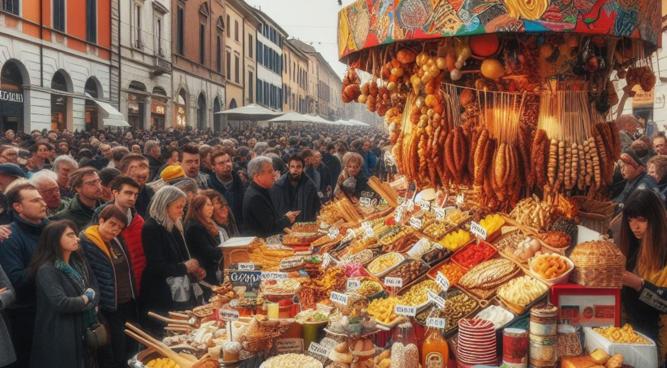Table of Contents
Introduction:
A Food Service Trade Organization is a vital industry association that supports, connects, and empowers professionals and businesses within the culinary and food service sector.
In the perpetually changing realm of food service, institutions assume a central position in molding the sector’s environment. These establishments, often referred to as culinary industry associations, act as vital channels for enterprises and experts within the gastronomic domain. Through their abundance of expertise, assets, and dedicated support endeavors, these groups enable stakeholders to traverse the intricate landscape of the food service sector, safeguarding its expansion and endurance.
Video Guide:
Understanding Food Service Trade Organizations:

Associations in the food service sector are distinct collectives advocating for diverse sectors within the gastronomic realm, encompassing eateries, event caterers, provision providers, and culinary experts. Their fundamental objective is to foster the advancement and maturation of the field through the provision of vital assistance, knowledge, and active promotion. Let’s delve deeper into their crucial functions:
- Advocacy and Representation: Food service trade organizations act as the voice of the industry, advocating for policies and regulations that benefit its members. They engage with government bodies, lobby for favorable legislation, and address issues ranging from food safety to labor standards. Their influence is instrumental in shaping the industry’s regulatory framework.
- Networking and Partnership: These associations provide priceless chances for professionals in the field to link up, exchange thoughts, and work together. By means of conventions, symposiums, and training sessions, participants can keep abreast of the most recent developments, breakthroughs, and superior methodologies in the culinary realm.
- Instruction and Skill Development: Numerous culinary industry groups supply educational materials, certifications, and instructional courses to enrich the competencies and wisdom of their constituents. This guarantees that industry experts remain competitive and well-informed regarding the constantly evolving benchmarks.
- Market Insights: Food service trade organizations often conduct research and gather market insights, providing members with data on consumer trends, emerging markets, and industry benchmarks. This data aids enterprises in crafting well-informed choices and maintaining a competitive edge.
- Advocacy and Promotion: Industry associations champion their constituents and the sector in its entirety via promotional campaigns, public image-building endeavors, and gatherings. These activities help raise awareness about the culinary sector and drive customer engagement.
- Access to Resources: Being a member of a culinary trade association provides entry to a plethora of assets, such as industry analyses, blueprints, and toolkits. This assistance streamlines operations, diminishes expenses, and fosters expansion for enterprises.
The Influence Of Culinary Trade Associations:

The sway of culinary trade associations extends broadly, offering advantages to various stakeholders within the sector:
- Gastronomy Entrepreneurs and Banquet Providers: For eatery proprietors and banquet service enterprises, trade groups deliver crucial aid in navigating the intricacies of managing a culinary enterprise. They offer guidance for menu innovation, logistics streamlining, promotional strategies, and workforce development.
- Suppliers and Dispatch Agents: Suppliers and dispatch agents rely on trade alliances to connect them with potential clients and stay abreast of market fluctuations. These associations foster business connections and assist suppliers in aligning their offerings with market needs.
- Cooks and Gastronomic Professionals: Culinary connoisseurs, including cooks, discover value in trade associations through educational schemes, certifications, and networking chances. These assets empower them to elevate their culinary expertise and remain competitive within their field.
- Patrons: Even patrons experience indirect benefits from culinary trade organizations. These organizations work to ensure food safety standards, support sustainable practices, and advocate for transparency in food labeling. These efforts contribute to a safer and more informed dining experience for customers.
Examples Of Food Service Trade Organization:
Several prominent food service trade organizations operate globally and regionally, each catering to specific segments of the industry:
- National Restaurant Alliance: This U.S.-centered association champions the concerns of more than one million dining establishments. It delivers a broad spectrum of offerings, spanning from advocacy to instructional initiatives, enhancing all facets of the restaurant sector.
- American Gastronomic Guild: Concentrating on gastronomic experts, this group delivers accreditations, learning opportunities, and networking chances for chefs, dessert chefs, and other gastronomic specialists.
- Global Banquet Enterprises Association: Catering enterprises across the globe gain from the assets and assistance supplied by this group, encompassing educational programs and industry insights.
- National Consortium of Culinary Appliance Fabricators: Suppliers and creators of culinary appliance machinery locate their hub within this association, which advances industry benchmarks and facilitates commerce affiliations.
Conclusion:
In the dynamic world of food service trade organizations serve as linchpins, connecting the diverse stakeholders of the industry. Their championing, enlightenment, and bolstering endeavors exert a profound influence on the expansion, creativity, and enduringness of the gastronomic realm. As culinary trade associations persistently transform and adjust to shifting eras, their pivotal position in sculpting the forthcoming destiny of the field remains irreplaceable. Whether you’re a dining establishment proprietor, culinary artist, provider, or patron, these associations assume a crucial responsibility in guaranteeing the prosperity of the culinary sector, both presently and in the forthcoming decades. For more visit Home
Certainly! Here are some frequently asked questions (FAQs) about Food Service Trade Organizations:
1. What is a Food Service Trade Organization?
A Food Service Trade Organization is a professional association or group that represents and advocates for the interests of businesses and individuals within the food service industry. These organizations work to support, promote, and advance the industry as a whole.
2. Why are Food Service Trade Organizations important?
Food Service Trade Organizations play a crucial role in the food service industry by providing a unified voice for businesses, advocating for policy changes, offering networking opportunities, providing resources and education, and fostering collaboration among industry stakeholders.
3. Who can join a Food Service Trade Organization?
Membership eligibility typically varies from one organization to another. In general, businesses and individuals working in the food service industry, such as restaurants, catering companies, food suppliers, chefs, and culinary professionals, can join these organizations.
4. What benefits can I expect from joining a Food Service Trade Organization?
Benefits often include access to industry-specific resources, educational programs, networking events, advocacy on industry issues, discounts on services and products, and opportunities to collaborate with peers and leaders in the field.
5. How can I find a Food Service Trade Organization that suits my needs?
You can search online, ask industry peers for recommendations, or contact your local chamber of commerce or business associations to find relevant Food Service Trade Organizations in your area. National or international organizations may also have chapters or affiliates in different regions.




